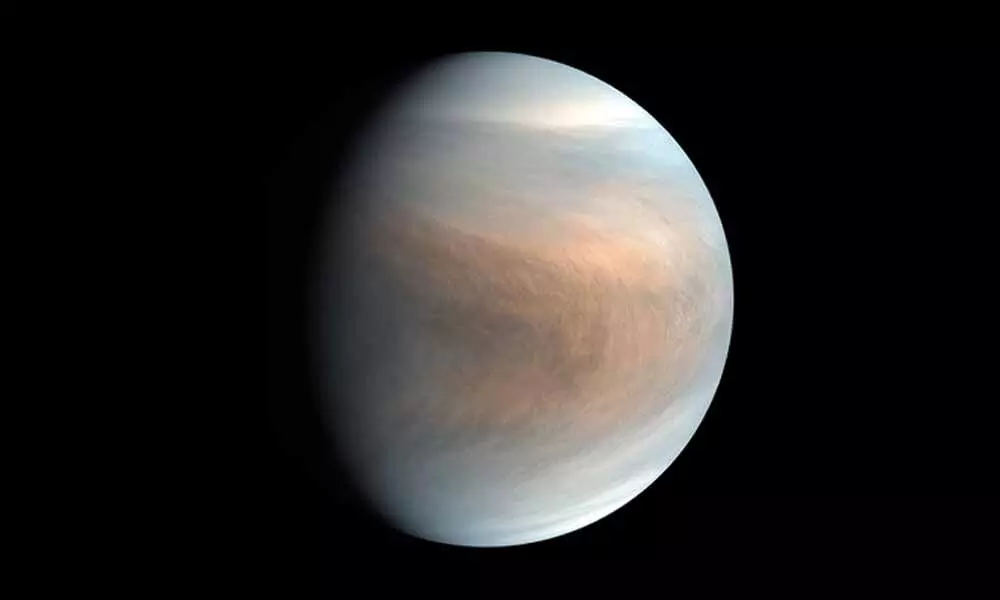Scientists Find a Possible Sign of Life on Venus

Scientists Find a Possible Sign of Life on Venus
The discovery of a strange gas in its atmosphere puts the planet “into the realm of a perhaps inhabited world,” a researcher says.
The discovery of a strange gas in its atmosphere puts the planet "into the realm of a perhaps inhabited world," a researcher says.
After the moon, Venus is the brightest object in the night sky, gleaming like a tiny diamond in the darkness. The planet is so radiant because of its proximity to Earth, but also because it reflects most of the light that falls across its atmosphere, more than any other world in the solar system.
Something really weird is happening in those clouds.
Scientists revealed today that they have detected traces of a gas in the Venusian atmosphere that, according to everything they understand about Venus, shouldn't be there. They considered many explanations for what could be producing the gas, known as phosphine, and settled on an explanation guided by what they know about our own planet. On Earth, phosphine—a toxic gas—is produced by microorganisms.
"As crazy as it might sound, our most plausible explanation is life," Clara Sousa-Silva, a molecular astrophysicist at MIT and one of the authors of the new study, told me.
Before everyone starts screaming, I need to emphasize that the discovery of phosphine molecules in Venus's atmosphere does not mean that scientists have found proof of alien life. The detection is simply evidence of a phenomenon scientists can't yet explain. The phosphine could be created by some form of life, or it could be forged by a chemical process that scientists just haven't seen before.
Either way, Venus, a world with a reputation for being hot and hellish, just became one of the most intriguing—and closest—spots in the universe to investigate the question of whether life exists beyond Earth. A NASA rover is currently on its way to Mars to look for signs of life, but the robot is designed to find long-dead microbes, preserved in the rusty soil for billions of years. The phosphine discovery presents the tantalizing possibility that life might be on Venus right now. If this discovery is confirmed, which will likely require sending a spacecraft, we would know for the first time in human history that the solar system has two planets where life exists. In a cosmic sense, we wouldn't be alone anymore.
At this moment, there are no spacecraft around Venus, and no rovers on its surface, which would melt them within minutes. The story of this discovery began on Earth, where Jane Greaves, an astronomer at Cardiff University in Wales, had read scientific papers positing that, if you were an alien astronomer looking at Earth from afar, phosphine could be a biosignature for our planet. She decided to test the idea out on Venus, which is similar in size and mass, using a ground-based telescope in Hawaii to observe the planet for just a few hours, almost on a whim. "I wasn't really expecting that we'd detect anything," Greaves told me.
She found the signature of phosphine, a distinct pattern of light the gas emits from within the planet's clouds. Observations from another telescope, in Chile, captured the same mark. Soon, Greaves was in touch with Sousa-Silva at MIT, who has spent her career studying phosphine.
Venus is a notoriously inhospitable planet, where surface temperatures hover around 860 degrees Fahrenheit (460 Celsius). Travel high into the atmosphere, where it's cooler, and you'll find more bearable, even comfortable, temperatures, closer to what we experience on Earth. This is where the telescopes detected the signature of phosphine. But Venus's atmosphere is so acidic, with clouds made of droplets of sulfuric acid, that any phosphine would be quickly zapped. For the gas to stick around, something must replenish the supply.
Until now, phosphine has been detected only on three other worlds in the solar system. On Earth, it is found in swamps and marshlands, and in the intestines of some animals. On Jupiter and Saturn, the gas is forged within the planets' violent storms, under extreme conditions that aren't known to exist anywhere else. Sousa-Silva and the other researchers mimicked similar processes on Venus using computer simulations. They sent jolts of lightning coursing through the atmosphere and meteorites crashing through the clouds. They simulated the scraping of crust against crust, even though Venus doesn't have plate tectonics, because they couldn't think of anything else that could produce enough energy to force phosphine into existence.
The researchers managed to produce phosphine in these scenarios in tiny amounts, not enough to be detected from Earth. Which is how Sousa-Silva and the team found themselves seriously considering the explanation that scientists keep at the very bottom of the list because it's usually the least likely. As the saying goes, extraordinary claims require extraordinary evidence. "I'm skeptical," Sousa-Silva said. "I hope that the whole scientific community is just as skeptical, and I invite them to come and prove me wrong, because we're at the end of our expertise."
Several scientists who specialize in Venus, and who were not involved in the new research, say the findings are compelling. Like Sousa-Silva, they are skeptical. Some point out that, after more observations, the signature of phosphine could turn out to be the trademark of another molecule. Astronomers are the first to doubt data that hint at life, but this time, they seemed willing to entertain the possibility. "This discovery is now putting Venus into the realm of a perhaps inhabited world," says Martha Gilmore, a planetary geologist at Wesleyan University who has proposed to NASA a robotic mission to study Venus in depth.
The idea that life might reside in Venusian clouds has been floating around in the astronomy community for decades. Carl Sagan, the astronomer who popularized the "extraordinary claims" mantra, explored the concept in a 1963 paper with the biophysicist Harold Morowitz. Before Venus became a planet-size furnace, it was a watery world, covered in oceans that flowed for billions of years, as habitable as the seas of Earth. As the atmosphere swelled with heat-trapping gases and water evaporated into space, life-forms on the surface, forced to adapt, could have escaped into the skies. If life indeed resides in Venus's atmosphere, it might be the last remnant of a wrecked biosphere.
Sousa-Silva daydreams often about what such aerial life-forms might be like. "It's fascinating to imagine what kind of complexity could arise if you're not scared of sulfuric acid," she said. Venusian life-forms would have a more difficult existence if they resembled earthly microorganisms, Sousa-Silva says, because they would have to work hard to extract the very little water vapor in the atmosphere to survive.
Recognizable or not, any Venusian life would probably smell bad. Phosphine is so toxic that it has been used as a chemical agent in warfare and by terrorist groups. "We've evolved to think that toxic things smell bad," Sousa-Silva said, adding that any Venusian beings might be hardwired to feel the same way. Venusian life "would smell disgusting [to us], but we would be repulsive to them," she said.
The presence of phosphine on Venus and its mystery origins mean scientists around the world must reexamine what they think they know about the second planet from the sun. The discovery also bolsters the argument for sending new missions to Venus, such as orbiters to map the cloud tops and balloon probes to fall through the atmosphere. No space agency has visited Venus since 1985, when the Soviet Union deployed the last probes of a two-decade effort to study the planet. "We have to go back to that atmosphere and figure out, what could this mean?" Jim Garvin, the chief scientist at NASA's Goddard Space Flight Center, who leads a proposed mission to Venus, told me.
Even with spacecraft on site, the mystery of phosphine might not be easily solved. Consider methane, another gas produced by tiny microbes on Earth. Over the years, rovers and other spacecraft on Mars have detected methane in the atmosphere. Methane molecules don't survive long in Martian skies, thanks to the sun's radiation and interaction with other gases. This has led some scientists to suggest the presence of methane-producing life-forms. But natural, boring interactions between rock and water can also produce the gas, and the spikes could be puffs of molecules, formed billions of years ago, rising through new cracks in the ground. Today, the methane on Mars remains a mystery.
If scientists ever find life on Venus, that discovery will ground our ideas about extraterrestrial beings in new reality. For so long, the leading candidates have been mysterious beings hidden in the soil on Mars or tiny creatures swimming in subsurface oceans on icy moons such as Europa and Enceladus. Perhaps it's time to imagine life suspended in the skies of a nearby world. What if, after years of space exploration, scientists find life on Venus instead of Mars? "The Mars people will be so mad," Gilmore told me, laughing. "I don't care where we find it. If we find it next door, even better."
Source: theatlantic.com



















